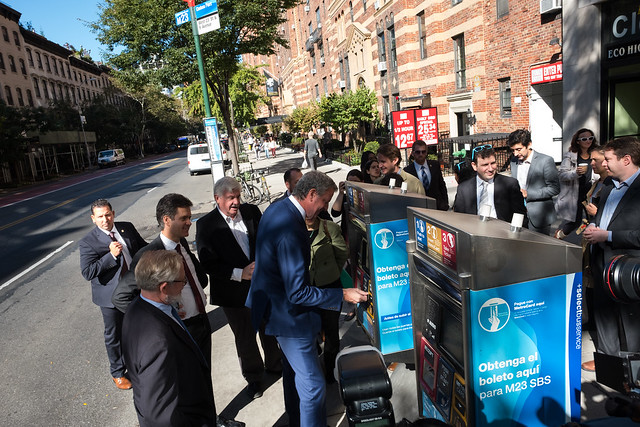Mayor de Blasio's plan to speed up New York City's slowest-in-the-nation buses by 25 percent in one year will include special treatments such as barrier-protected bus lanes — one of the most drastic efforts to keep drivers from continually getting in the way.
Finally putting some details into his promise to improve bus service, the mayor said his "Better Buses Action Plan" would include efforts such as offset and barrier-protected bus lanes, enhanced bus stop design and spacing, pedestrian safety improvements along routes, and studies into how to expand bus stop shelters and accessibility throughout the system.
The goal is to get average bus speeds up to 10 miles per hour, starting with targeted improvements at 24 locations across the five boroughs where bus speeds are especially slow. The city DOT hopes its efforts will complement the MTA's own plan [PDF].
"We are rolling out ... projects that are going to help hundreds of thousands of New Yorkers get where they need to go quicker, and we're going to do it very very quickly," the mayor said at a press conference announcing the initiative. "We know that people's lives get disrupted all the time [by slow bus service], and it shouldn't be that way."
A plurality of the changes will be in Manhattan. On Lexington Avenue between 60th and 96th streets, for example, the city plans to install an "offset" (i.e., not curb-adjacent) bus lane, "bus boards," and dedicated delivery zones to prevent double-parking. New bus lanes will also be going in on the FDR Drive between Brooklyn Bridge and Battery Park, Allen Street between Grand Street and Houston Street, Battery Place between West Street and Broadway, and 96th Street river-to-river.
Similar improvements are coming to notoriously slow blocks outside of Manhattan as well, including Church Avenue along the B35 route and segments of Utica Avenue and Flushing Main Street that don't currently have bus lanes.
Existing bus lanes will also be getting upgrades, including 42nd Street, Madison Avenue, Webster Avenue in the Bronx, Woodhaven Boulevard in Queens, and Livingston Street in downtown Brooklyn.
The section of Livingston Street in question — between Flatbush Avenue and Boerum Place — earned notoriety last year when Streetsblog documented the slew of placard-wielding vehicles parked in it nearly every day. There, DOT is contemplating physical barrier to keep the lanes clear, according to the report.
Thursday's announcement builds on NYPD bus lane and bus stop enforcement efforts that began in January. Since then, police have towed 432 bus lane blockers and doled tickets to another 17,000 bus lane violators. That's already having an impact, according to Deputy Mayor for Operations Laura Anglin.
"The presence of law enforcement is really starting to make a difference," she said.
The data don't back up that assertion. MTA data show average bus speeds actually dropped in every borough between January and March, albeit by just one-tenth of a percent.
The plan is part of a larger "2019 OneNYC strategic plan," which the de Blasio administration will release next week. In addition to the bus improvements, the mayor also announced two more congestion-cutting plans: He hopes to triple the number of business enrolled in DOT's overnight deliveries program, and the administration will study and pilot pedestrian-only streets in Lower Manhattan.
Pressed by some non-Streetsblog reporters on the announcement's impact on drivers, de Blasio was surprisingly resolute, insisting that his top priority was to help the city's 700,000 bus commuters.
The congestion pricing plan passed by the state legislature earlier this month will lead to faster speeds for drivers, and offers the city an opportunity to provide similar benefits to pedestrians and bus riders, the mayor said.
"Right now, I'm thinking about the sheer number of people who ride our buses," he said. "When [the buses] are working, they're far superior to driving in the city."






